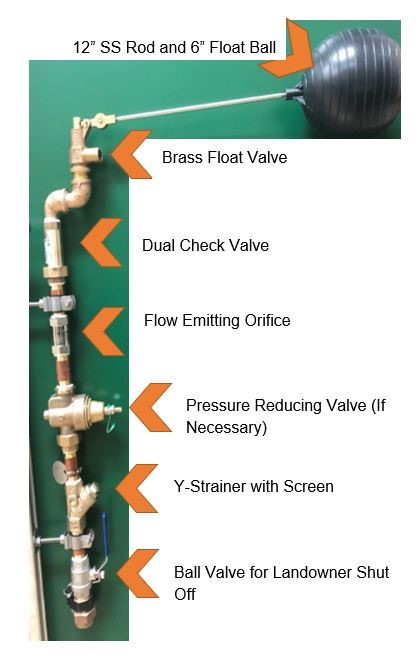
Caring for your Rural Water Emitter
The equipment provided as part of your rural water service is the landowners responsibility to care for, maintain, and replace if failure occurs. Since January 1, 2020, the County has no longer been providing replacement parts for the flow emitter assembly that have failed due to several reasons.
Did You Know?
The operating pressure of the County Rural Water System can be anywhere between 20 and 120 PSI (pounds per square inch)
- This is why we recommend using pipe rated for 200 PSI and potable water on your side of the system.
- At some of the higher operating pressures, one small leak can turn into a large leak very quickly. Water at this pressure can cut through the brass fittings in your equipment if not sealed properly.
The valve that shuts your water off in your cistern/tank uses the same technology as a toilet bowl float.
- The buoyant force of the water raises the ball, allowing a valve to close and stop water flow into your tank. It is important to ensure you have a 12” stainless steel rod, a 6” float ball, and the rod is set as close to parallel with the ground as possible. This will create the greatest closing force possible. How many times have you walked into a bathroom and heard a toilet running? Consider this when thinking about your water service.
- You are free to look at other options for shutting the water off when it is full. Electric Solenoid, plastic valve, etc…
Ice and/or debris in your cistern can be detrimental to the life of your equipment
- Any form of ice, frost, or debris that gets in your cistern can cause the shut off valve to not seal properly. When the valve doesn’t seal properly, the high water pressure can compromise the valve.
- Consider using a heat lamp, or a floating cattle water heater in your tank over the winter months if it is susceptible to freezing conditions.
As per the County’s Water & Sewer Bylaw, only authorized personnel are allowed to operate any of the County owned valves (curb stops) or hydrants on the distribution system.
- Potable water delivery is a great responsibility. Only those trained to operate the system are authorized to do so.
- Incorrectly operating a valve can cause water flow to fluctuate suddenly, sending a pressure wave down the line.
- Any unauthorized person causing damage to a hydrant or valve shall be responsible for the cost of repairs as a result of any damage caused.
If you need to turn your water service off, there is a ball valve on the flow emitter that you can operate manually (see picture below). If you require it shut off at the curb stop please call NRSC at 403-794-4000. There is a charge for each turn on and turn off at the curb stop as per the County of Newell’s Schedule of Fees Bylaw.
Best Practices
Don’t Forget your Flow Emitter! Check your flow emitter at least once weekly. Your water level should never rise above the float ball. If it does, turn your ball valve off then troubleshoot the issue.
Set your Levels for SuccessEnsure your rod is set as close to parallel with the water level as possible. This will ensure you have the maximum closing force on the valve.
You have been provided with a rail system to mount in your cistern. Consider dropping your levels to the amount of water you need. This will ensure your water is refreshed often and help reduce freezing.
Frost and Ice are the Enemies
Any formation of frost or ice in your cistern is detrimental to the life of your equipment. Consider installing a heating source through the winter months to ensure your cistern remains frost free!




